When the COVID-19 pandemic struck in March 2020, health care providers had to learn in a hurry how to navigate telemedicine and virtual, distant encounters with patients—using technologies that were well-established but not as widely used. Hospitalists were no exception. Sometimes their pandemic virtual visit was just down the hall to a hospitalized COVID-19 patient in isolation. Other times it was helping other clinicians who needed expert medical support during patient surges across the state or the country.
Now that COVID-19 has become more endemic, hospitalists are still trying to clarify their roles and responsibilities, with an eye to the future and the evolving definition of a hospitalist. Will that include hospital at home, the range of post-acute settings where some hospitalists are finding new roles, or the new post-discharge transitional follow-up programs?1 Could telemedicine help with other kinds of surges, crises, and natural disasters in hospitals?
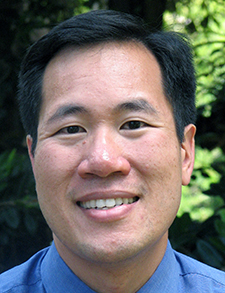
Dr. Ong
In 2018, hospitalists Michael K. Ong, MD, FACP, PhD, and Daniel Brotman, MD, MHM, penned an editorial in the Journal of Hospital Medicine entitled The Virtual Hospitalist: The Future is Now.2 Acknowledging that medicine traditionally has been slower than some other industries to “embrace the digital age,” they suggested that new applications of the electronic health record (EHR), and digital tools such as video or remote sensor technology, were becoming increasingly important in medicine—and for hospitalists.
Dr. Ong, who practices at the Veterans Administration Greater Los Angeles Healthcare System and at the University of California Los Angeles’s hospitals, was recently asked where hospitalists are today relative to these virtual applications. “Some of the technological changes during the pandemic that we might have expected in how we conduct inpatient care haven’t really happened yet (in hospital medicine),” he said. “But as we continue to innovate in terms of staffing models and how we manage patients, my guess is that we will see much more of what we’ve already seen with intensive care units (ICU) and tele-ICU programs.”
Some new tools haven’t been incorporated into routine medical practice for reasons ranging from cost to security and privacy concerns, to reimbursement. But regulatory limitations remain the biggest barrier, he says, along with the challenges of obtaining privileges at a given hospital. “In the future, we likely will be triaging more complex patients, ideally moving them more quickly to the facilities that have the necessary diagnostic tools,” Dr. Ong said.
Rural links lead the way
The best-known application of telemedicine is the professional support of distant hospitalists to small, rural, isolated, understaffed, or critical-access hospitals that, for varied reasons, can’t deploy sufficient physician coverage in person 24-7 for their acutely ill patients. According to a 2018 article in the Journal of Hospital Medicine, telemedicine “virtual hospitalists” may expand critical-access hospital capabilities at a fraction of the cost, and the intervention is well-received by staff at the rural hospital and by its patients.3
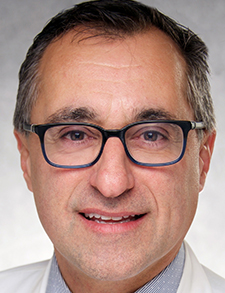
Dr. Kaboli
A follow-up study in rural Veterans Affairs (VA) hospitals from 2021 confirmed that rural hospital administrators perceived tele-hospitalist models as a viable option to address their staffing needs and improve quality of care.4 According to VA hospitalist Peter J. Kaboli, MD, FACP, SFHM, executive director of the VA Office of Rural Health, professor of medicine at the University of Iowa Carver College of Medicine in Iowa City, Iowa, and one of the authors of the latter study, the Tomah VA Medical Center, a small rural VA hospital in Tomah, Wisc., (population 9,570) did not have enough physicians or hospital staff to cover its patients 24-7. So the Iowa City VA Medical Center, 200 miles away, offered hospital medicine coverage as a telemedicine service with an advanced practice practitioner (APP) holding down the onsite coverage.
“Having someone physically present in the room with the patient and family is important,” Dr. Kaboli said. “We work with them so they can do the physical exam and be available to respond to emergencies. Then we round together by video as a team.” Similar initiatives, depending on local geography, are underway in other VA regions, he said. “We need to have more of those services available for small hospitals. That way their practitioners don’t end up feeling professionally isolated and they can have expert help when they need it.”
How does the telemedicine link work functionally? These joint interactions use a computer on wheels with a camera and a microphone, wheeled to the patient’s hospital room. “You don’t have to buy a high-priced robot to do this. We feel like we can provide the level of care that’s needed, using our expertise as hospitalists,” Dr. Kaboli said.
“I can be sitting at my computer in my office with three screens and the EHR, so I can be seeing the patient as well as reviewing the chart, or writing orders, or chatting with my team.” Plus, for the 10 to 20 minutes the doctor spends talking with the patient, there might be 30 minutes before and after, taking care of myriad details. “I can be very efficient sitting at my computer doing all of the things in the EHR that need to be done. I could be covering one or more rural hospitals.” And the tele-hospitalist can be physically located anywhere, say, at a ski resort in Colorado, fresh off the slopes.
Not just for rural hospitals
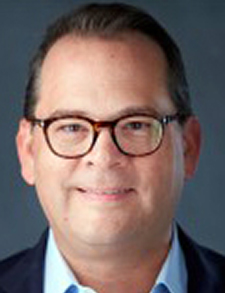
Dr. Carpenter
Brian Carpenter, MD, SFHM, chief medical officer for telemedicine at Tacoma, Wash.-based national hospitalist chain Sound Physicians, started as a practicing hospitalist trained in med-peds, but took on various leadership roles when he joined Sound Physicians in 2014. “I’ve been here since the birth of telemedicine at Sound Physicians, predating the pandemic. We started with four or five hospitals and are now up to 30 that we cover across the country.”
There is a belief that telemedicine is primarily for rural hospitals, which is true enough, Dr. Carpenter said. “But our footprint covers anywhere from critical access-sized to large, inner-city hospitals.” Sound employs about 45 physicians on its tele-hospitalist service, with several service-delivery options for the contracting hospitals.
The first is a true tele-hospitalist who is on call, covering the facility at night—doing everything from video-enabled admissions to rapid response like a traditional in-person nocturnist. Where the hospital requires a boots-on-the-ground hospitalist to attend to patients admitted from the emergency department, the tele-hospitalist can handle cross-coverage calls. Somewhere in between is for hospitals staffed at night with APPs, although their hospital bylaws still require some level of physician oversight and support for the APP. That is where the tele-hospitalist can be leveraged to provide peer-to-peer support to the in-house APPs, Dr. Carpenter says.
Sound Physicians staffs its telemedicine by divisions or pods, with each division comprising between five and 12 hospitals. “We have to be strategic in how we align our physician pods to states and hospitals since both state licensure and hospital credentialing can take months to complete,” Dr. Carpenter said.
The Interstate Medical Licensure Compact helps expedite state licensure for qualified physicians, but it still takes time to get a physician credentialled by a given hospital. Another limiting factor is how many EHRs the hospitalist needs to log in and out of during a shift because they can be cumbersome.
“We opted not to go with a ‘bunker’ model for the tele-hospitalist service, because it would limit our ability to recruit,” he said. “So, we went with a work-from-home model. We send them the equipment, two monitors, a desktop, and a headset, and we partner with a platform that processes all the requests for consultation from the hospitals electronically and routes them to the doctor who is on the schedule.”
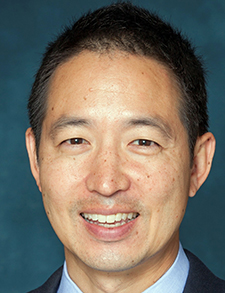
Dr. Shen
Tele-hospitalist applications skyrocketed during the COVID-19 pandemic, after simmering in the background, said Mark Shen, MD, FAAP, SFHM, a one-time pediatric hospitalist, digital health pioneer, and current CEO of two small surgical hospitals in Austin, Texas. “Sure, the technology is getting easier, with more integration with the EHR, and that’s a benefit. But what really changed adoption was the pandemic, with the result that the concept of video visits has been integrated more permanently into many doctors’ workflows. What makes sense, as we continue down the path to value in health care, is that we pair telemedicine workflows to the movement toward hospital at home,” he said.
“That’s where there’s a real opportunity, with a movement that’s still relatively young but growing quickly. A hospital-at-home program based in a hospital system doesn’t need its doctors to be out driving all over town. Other team members can be out on the road and in the home and the hospitalist can connect with them via the technology.”
Dr. Shen also appreciates the opportunities for his hospital’s physicians to connect virtually with medical specialists. For small, independent hospitals like his, that may mean a relationship with a national telemedicine company. “Say we need a neurology consult. They have a big network and can plug us into a consultation with a neurologist who can help us, eliminating the need to contract directly with specialists who have to be on call for infrequent needs,” he said.
New applications of telemedicine
During the pandemic, New York-Presbyterian/Weill Cornell Medical Center in New York City actively deployed hospitalists virtually to help with issues such as high patient census and acuity, limited access to personal protective equipment, and increased communication challenges due to visitor restrictions.
An article about this deployment in the Journal of General Internal Medicine noted that primary palliative care was another application, incorporating virtual, advance-care, planning discussions with patients and families.5 Another need was how to take advantage of the skills of practitioners who were eager to help in the crisis but needed to work from home due to pregnancy, comorbidities, exposure to COVID-19, or recovery from illness. Initially, 15 experienced hospitalists were assigned to work virtually. They also helped train physicians from other specialties who were redeployed in the hospital during COVID-19 surges.
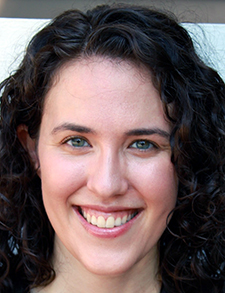
Dr. Bloom-Feshbach
“Historically, hospital medicine has been defined by our setting. We have a particular set of skills—processing a lot of clinical data and dealing with patient acuity with creativity and flexibility. We can actually apply these skills in different settings, including beyond the hospital walls,” said Kimberly Bloom-Feshbach, MD, a hospitalist at Weill Cornell, director of its virtual hospitalist program and lead author of the article about its COVID-19 tele-hospitalist pilot. She and colleagues, including hospitalist Rebecca Berger, MD, are leading the way on another application in collaboration with Westchester Behavioral Health Center, Weill Cornell’s affiliated psychiatric hospital 22 miles away in White Plains, N.Y.
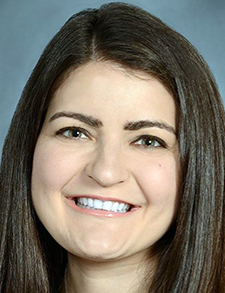
Dr. Berger
“We adapted our COVID-19 model to medical consultations for a psychiatric hospital,” Dr. Berger said. “We’re not practicing telemedicine in the same way that many other physicians are practicing it. The majority of our work is not directly patient-facing, but consulting with other clinicians,” she said. “The model is about maximizing the expertise of the hospitalist working virtually, supporting our on-site team members.”
There need to be clinicians on-site, typically at least one internist during the day plus APPs, with one hospitalist joining virtually, 24-7. The in-person and virtual hospitalists divide tasks but also come together to discuss cases. The hospitalist doesn’t need to be physically present to review every patient’s history and physical or do chart reviews and medication reconciliations.
Battling burnout
Telemedicine models are an exciting development given widespread concerns about the sustainability of hospital medicine as a long-term career—with its shifts, hours, and all the walking around. “We’re finding it can be physically more sustaining for hospitalists who don’t have to come in person to work every day,” Dr. Bloom-Feshbach said. “Bringing this option to them can be very helpful for their well-being in their jobs, and they say they enjoy it. It’s the flexibility of working from home with a different pace of work and the unique clinical challenges.”
Dr. Bloom-Feshbach said she’s surprised at how well she’s taken to the model of the virtual hospitalist. “I’m someone who really loves direct contact with patients, you know, sitting by the bedside, holding someone’s hand when conveying serious news. It has been humbling and exciting for me to learn how we can use technology to enhance what are already great skills of hospitalists,” she said.
“There will never be a replacement for some of the things we all love about bedside medicine. But how can we extend ways to deliver humanistic care through these virtual technologies—always viewing it as a complement, not a replacement?”
“I recommend it to my colleagues—something to try, to see if they like it, but also to see the limits to what we can do by telemedicine,” Dr. Kaboli said. “I only do it for a few weeks out of the year, but it’s a way to add variety into how we provide patient care as hospitalists.”
Larry Beresford is an Oakland, Calif.-based freelance medical journalist, specialist in hospice and palliative care, and long-time contributor to The Hospitalist.
References
- Beresford L. Hospitalists lead the way for hospital at home programs. The Hospitalist website. https://www.the-hospitalist.org/hospitalist/article/33125/hospital-medicine/hospitalists-lead-the-way-for-hospital-at-home-programs/. Published September 1, 2022. Accessed November 3, 2023.
- Ong MK, Brotman DJ. The virtual hospitalist: the future is now. J Hosp Med. 2018; 13(11);798-9.
- Kuperman EF, Linson EL, et al. The virtual hospitalist: A single-site implementation bringing hospitalist coverage to critical access hospitals. J Hosp Med. 2018;13(11):759-63.
- Moeckli J, Gutierrez J, et al. perceived need and potential application of a telehospitalist service in rural america. Telemed J E Health. 2021;27(1):90-5.
- Bloom-Feshbach K, Berger RE, et al. The virtual hospitalist: A critical innovation during the COVID-19 crisis. J Gen Intern Med. 2021;36(6):1771-4.